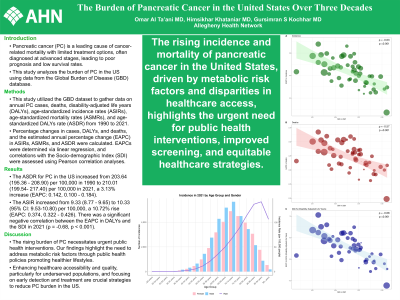Monday Poster Session
Category: Biliary/Pancreas
P1769 - The Burden of Pancreatic Cancer in the United States Over Three Decades
Monday, October 28, 2024
10:30 AM - 4:00 PM ET
Location: Exhibit Hall E

Has Audio
- OA
Omar Al Ta'ani, MD
Allegheny Health Network
Pittsburgh, PA
Presenting Author(s)
Omar Al Ta'ani, MD1, Aseel Saadeh, MD2, Himsikhar Khataniar, MD3, Gursimran S. Kochhar, MD, FACG1
1Allegheny Health Network, Pittsburgh, PA; 2Geisinger Medical Center, Danville, PA; 3Allegheny General Hospital, Pittsburgh, PA
Introduction: Pancreatic cancer (PC) is a leading cause of cancer-related mortality with limited treatment options, often diagnosed at advanced stages, leading to poor prognosis and low survival rates. In the United States (US), disparities in healthcare access and quality, alongside prevalent risk factors such as obesity and smoking, exacerbate this issue. Additionally, there are no general population screening recommendations. Our study analyzes the burden of PC in the US using data from the Global Burden of Disease database.
Methods: Data on annual PC cases, deaths, disability-adjusted life years (DALYs), age-standardized incidence rates (ASIR), age-standardized mortality rates (ASMR), and age-standardized DALYs rate (ASDR) from 1990 to 2021 were collected. Percentage changes in cases, DALYs, and deaths, and the estimated annual percentage change (EAPC) in ASIR, ASMR, and ASDR were calculated. EAPCs were determined via linear regression, and correlations with the Socio-demographic Index (SDI) were assessed using Pearson correlation analyses. All analyses were conducted using R programming version 4.3.3.
Results: In 1990, there were 29,016 (27,075 - 30,096) deaths attributable to PC, which increased to 57,098 (52,182 - 59,928) in 2021, a 96.8% increase. The ASDR for PC in the US increased from 203.64 (195.36 - 208.90) per 100,000 in 1990 to 210.01 (199.54- 217.40) per 100,000 in 2021, a 3.13% rise (EAPC: 0.142, 0.100 - 0.184). The age-standardized incidence rate (ASIR) increased from 9.33 (8.77 - 9.65) to 10.33 (9.53-10.80) per 100,000, a 10.72% rise (EAPC: 0.374, 0.322 - 0.426). There was a significant negative correlation between the EAPC in DALYs and the SDI in 2021 (ρ = -0.68, p < 0.001). DALYs attributable to high BMI and high fasting plasma glucose increased from 1990 to 2021, while those attributable to smoking decreased.
Discussion: The rising burden of PC in the US necessitates urgent public health interventions. Our findings emphasizes the need to address metabolic risk factors through public health policies promoting healthier lifestyles. Additionally, the significant negative correlation between SDI and PC burden suggests improving socioeconomic conditions and healthcare access can mitigate the disease's impact. Enhancing healthcare accessibility and quality, particularly for underserved populations, and focusing on early detection and treatment, along with the development of effective screening interventions, are key strategies to reduce the burden of PC and improve patient outcomes.

Disclosures:
Omar Al Ta'ani, MD1, Aseel Saadeh, MD2, Himsikhar Khataniar, MD3, Gursimran S. Kochhar, MD, FACG1. P1769 - The Burden of Pancreatic Cancer in the United States Over Three Decades, ACG 2024 Annual Scientific Meeting Abstracts. Philadelphia, PA: American College of Gastroenterology.
1Allegheny Health Network, Pittsburgh, PA; 2Geisinger Medical Center, Danville, PA; 3Allegheny General Hospital, Pittsburgh, PA
Introduction: Pancreatic cancer (PC) is a leading cause of cancer-related mortality with limited treatment options, often diagnosed at advanced stages, leading to poor prognosis and low survival rates. In the United States (US), disparities in healthcare access and quality, alongside prevalent risk factors such as obesity and smoking, exacerbate this issue. Additionally, there are no general population screening recommendations. Our study analyzes the burden of PC in the US using data from the Global Burden of Disease database.
Methods: Data on annual PC cases, deaths, disability-adjusted life years (DALYs), age-standardized incidence rates (ASIR), age-standardized mortality rates (ASMR), and age-standardized DALYs rate (ASDR) from 1990 to 2021 were collected. Percentage changes in cases, DALYs, and deaths, and the estimated annual percentage change (EAPC) in ASIR, ASMR, and ASDR were calculated. EAPCs were determined via linear regression, and correlations with the Socio-demographic Index (SDI) were assessed using Pearson correlation analyses. All analyses were conducted using R programming version 4.3.3.
Results: In 1990, there were 29,016 (27,075 - 30,096) deaths attributable to PC, which increased to 57,098 (52,182 - 59,928) in 2021, a 96.8% increase. The ASDR for PC in the US increased from 203.64 (195.36 - 208.90) per 100,000 in 1990 to 210.01 (199.54- 217.40) per 100,000 in 2021, a 3.13% rise (EAPC: 0.142, 0.100 - 0.184). The age-standardized incidence rate (ASIR) increased from 9.33 (8.77 - 9.65) to 10.33 (9.53-10.80) per 100,000, a 10.72% rise (EAPC: 0.374, 0.322 - 0.426). There was a significant negative correlation between the EAPC in DALYs and the SDI in 2021 (ρ = -0.68, p < 0.001). DALYs attributable to high BMI and high fasting plasma glucose increased from 1990 to 2021, while those attributable to smoking decreased.
Discussion: The rising burden of PC in the US necessitates urgent public health interventions. Our findings emphasizes the need to address metabolic risk factors through public health policies promoting healthier lifestyles. Additionally, the significant negative correlation between SDI and PC burden suggests improving socioeconomic conditions and healthcare access can mitigate the disease's impact. Enhancing healthcare accessibility and quality, particularly for underserved populations, and focusing on early detection and treatment, along with the development of effective screening interventions, are key strategies to reduce the burden of PC and improve patient outcomes.

Figure: The relationship between EAPC in DALYs, Incidence, and Deaths with the sociodemographic index in 2021
Disclosures:
Omar Al Ta'ani indicated no relevant financial relationships.
Aseel Saadeh indicated no relevant financial relationships.
Himsikhar Khataniar indicated no relevant financial relationships.
Gursimran Kochhar indicated no relevant financial relationships.
Omar Al Ta'ani, MD1, Aseel Saadeh, MD2, Himsikhar Khataniar, MD3, Gursimran S. Kochhar, MD, FACG1. P1769 - The Burden of Pancreatic Cancer in the United States Over Three Decades, ACG 2024 Annual Scientific Meeting Abstracts. Philadelphia, PA: American College of Gastroenterology.
